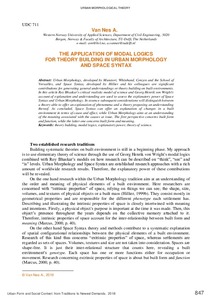Показать сокращенную информацию
THE APPLICATION OF MODAL LOGICS FOR THEORY BUILDING IN URBAN MORPHOLOGY AND SPACE SYNTAX
| Автор | Van, Nes A. | |
| Дата внесения | 2019-07-10T09:52:27Z | |
| Дата, когда ресурс стал доступен | 2019-07-10T09:52:27Z | |
| Дата публикации | 2019-05 | |
| ISBN | 978-5-7638-4127-5 | |
| URI (для ссылок/цитирований) | https://elib.sfu-kras.ru/handle/2311/111760 | |
| Описание | Proceedings of the XXV ISUF International Conference “Urban Form and Social Context: from Traditions to Newest Demands” (Krasnoyarsk, July 5–9, 2018) | ru_RU |
| Аннотация | Urban Morphology, developed by Muratori, Whitehand, Conzen and the School of Versailles, and Space Syntax, developed by Hillier and his colleagues are significant contributions for generating general understandings or theory building on built environments. In this article Roy Bhaskar's critical realistic model of science and Georg Henrik von Wright's account of explanation and understanding are used to assess the explanatory power of Space Syntax and Urban Morphology. In essence subsequent considerations will distinguish between a theory able to offer an explanation of phenomena and a theory proposing an understanding thereof. As concluded, Space Syntax can offer an explanation of changes in a built environment in terms of cause and effect, while Urban Morphology aims at an understanding of the meaning associated with the causes at issue. The first perspective concerns built form and function, while the latter one concerns built form and meaning. | ru_RU |
| Язык | en | ru_RU |
| Издатель | Siberian Federal University | ru_RU |
| Издатель | Сибирский федеральный университет | ru_RU |
| Тема | theory building, modal logics, explanatory power, theory of science. | ru_RU |
| Название | THE APPLICATION OF MODAL LOGICS FOR THEORY BUILDING IN URBAN MORPHOLOGY AND SPACE SYNTAX | ru_RU |
| Тип | Conference Item | ru_RU |
| Тип | Conference Paper | ru_RU |
| Контакты автора | Van, Nes A. : Western Norway University of Applied Sciences, Department of Civil Engineering, 5020 Bergen, Norway & Faculty of Architecture, TU-Delft, The Netherlands e-mail: avn@hvl.no, a.vannes@tudelft.nl | ru_RU |
| Страницы | 847- 856 | ru_RU |
| Место издания | Красноярск | ru |
| Место издания | Krasnoyarsk | en |

